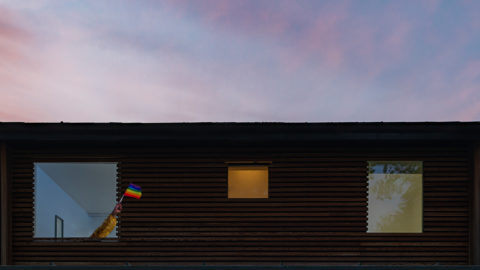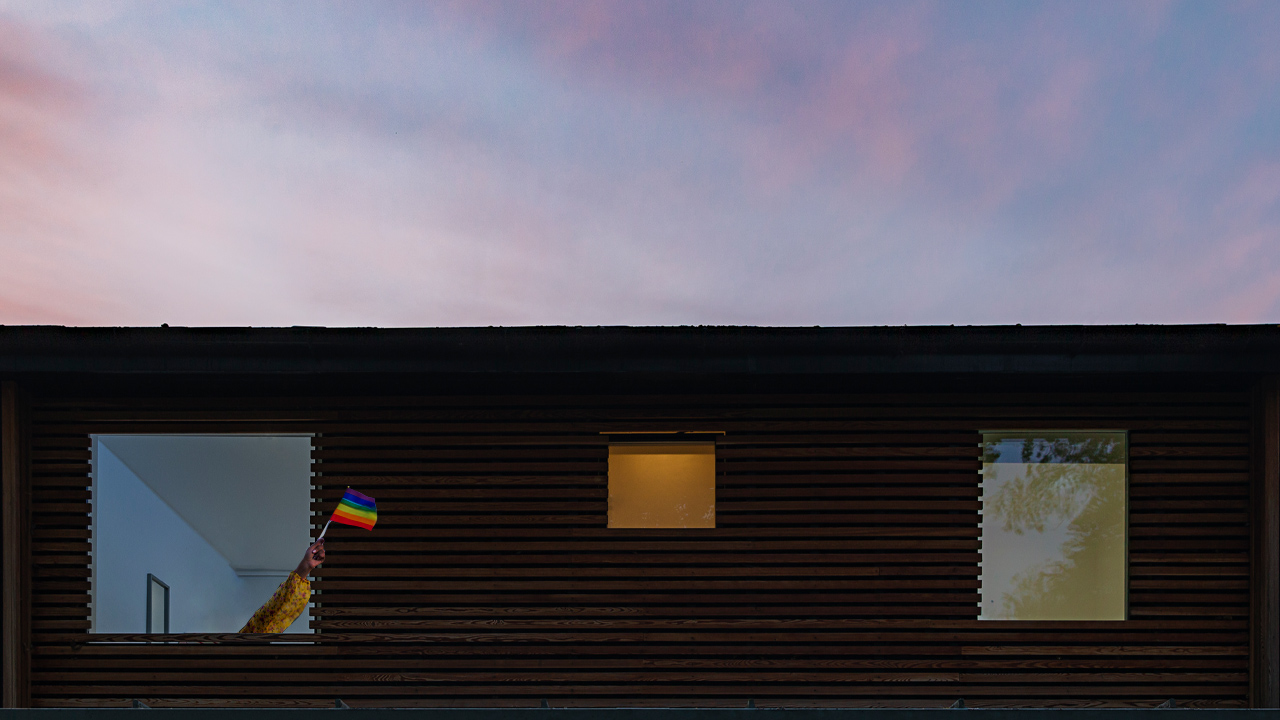How Quarantine Has Affected Queer Identity
Isolating at home with unsupportive families has been detrimental to many young people in the LGBTQ+ community. Here are strategies for coping and tips for how allies can help

In the three months since the novel coronavirus, also known as Covid-19, brought the world to a standstill, shelter-in-place policies across North America have left LGBTQ+ communities straining to connect. The pandemic has forced many young queer people into close quarters with family members who don’t support their sexuality or gender identity expression back into the closet.
One of those people is Ashleigh Rae Thomas, 25, an Afro-Jamaican non-binary lesbian living in Oshawa, Ont. They’ve been quarantining with their parents since March 15.
Thomas’s experience in isolation with family is reflective of what many people are experiencing: They’re an adult child under the same roof as their parents, trying to maintain some sense of privacy, all while creating their own “new normal” routine in a world that has physically distanced and shifted online. But their identity as a non-binary lesbian adds an extra layer of conflict in their home.
Thomas’s parents know they’re a lesbian, but not that they’re non-binary. “I didn’t know about gender things then,” they say, referring to when they first came out. They say they now wish they had waited to come out all at once. “Being non-binary is so personal to me,” Thomas says. “It’s so internal, it’s like a conversation with myself. I don’t need their approval for it. Being a lesbian means that I’m going to bring a girl home, but being non-binary…My parents are not ready for the whole transgender conversation. I feel like that’s the straw that’s going to break them.”
As a result, it’s affected Thomas’s ability to fully be themselves for months. “If I do little things it feels like I’m taking a huge risk,” they say. For example, Thomas has a pair of rainbow sunglasses that they wore around the house one day: “I was bracing myself for the comments.”
“It’s been hard because I spend quite a bit of time with my mom,” Thomas continues. “And I always want to talk to her about everything, and I can’t. She swears up and down that she’s not homophobic, she just doesn’t ‘agree with the lifestyle.’”
And though Thomas isn’t currently dating, they say that it’s been a problem in the past. “When I’m dating a girl, my parents refuse to meet them. They’re not allowed in the house,” Thomas says. “If I’m making phone calls to a girl that I’m interested in, I have to hide in my room so that they’re not over-hearing what we’re talking about or asking me who I’m talking to.” During our phone interview for this story, Thomas said that they had to ask their parents to leave the room, and then they asked why they couldn’t stay to listen to the call.
Even watching television has been a struggle for Thomas, who says that if a gay person is on the screen their father might say something homophobic. “It really upsets me but I can’t really do anything about it,” they say.
The pandemic is increasing health risks among LGBTQ+ youth
Thomas’s experience is common among LGBTQ+ young adults who have “launched” already, says Ashleigh Yule, a Calgary-based registered psychologist specializing in child and adolescent mental health with a focus on LGBTQ+ youth. She’s seen queer young adults who come to her practice after returning home from living away at university to increased scrutiny of their identity. Their gender expression or orientation is “always a debate with parents where it didn’t used to be at college,” Yule says. “When you’re not affirmed at home, sometimes school is the only place for you where you do experience that affirmation.” (Though school can be a safe place for LGBTQ+ youth, it’s important to note that many young people don’t have the opportunity to study away or pursue post-secondary education at all.)
Covid-19 has forced a similar situation, only augmented by the additional stress of living through a global pandemic. On top of the layers of oppression they already face, Yule says that young adults self-isolating with families who may or may not be accepting, face a heightened risk during this time: mainly being forced back into the closet, with increased anxiety, increased depressive symptoms, increased substance use and increased suicidal ideation.
“There’s a decade or two of really good, solid research showing that queer youth who don’t find acceptance at home have poor mental health outcomes,” Yule sys. “In Canada we have really great research through the Trans PULSE Project that shows that those statistics hold true for trans and gender diverse Canadians.”
But this research misses some key factors, Yule says, and it results in data that doesn’t fully encompass the scope of how LGBTQ+ youth are being affected when they live at the intersections of race, class and gender identity. “When we talk about research, there is also discrimination and privilege inherent in academic research. We don’t have lots of the data on ‘Well, how many intersections lead to what level of challenge or risk?’ because a lot of times, research is done through a very white lens. A lot of times it’s done through a very cis-normative, heteronormative lens and we’re only just starting to deconstruct that research approach so that we can actually capture appropriate representational data.”
But what is clear from the research is that the more layers of minority stress that a person is experiencing, the more challenges there are. And it doesn’t stop at mental health: Yule says that queer youth who don’t find acceptance face poor physical health outcomes as well. “Lots of trans and gender diverse individuals avoid going to the doctor [or] are nervous to go to the ER if they need emergency care,” she says. “[They’re] less likely to find inclusive healthcare.” A 2017 study at the University of British Columbia found that out of 923 trans or genderqueer youth, 34% neglected physical care due to how inexperienced and unfamiliar doctors were to their needs.
These are outcomes that already affect LGBTQ+ people outside of the context of Covid-19. Prolonged exposure to isolating at home with family members who are not accepting can exacerbate those outcomes.
But there are tangible ways we can cope
One of the first strategies that Yule usually recommends when young people come to her clinical practice is finding people who affirm them, but that’s become difficult since the pandemic began.
For Toronto’s Black LGBTQ+ youth, social gatherings like Black Queer Youth at the Sherbourne Health Centre, Black Coalition for AIDS Prevention (Black CAP), Friends of Ruby, programs at The 519, and queer parties like the RUDE Collective and Strapped TO have been essential physical safe spaces where they can be themselves. The pandemic has drastically limited this in-person interaction and moved participation entirely online. Pride celebrations worldwide have been either cancelled or moved online this year, too.
Thomas, who describes themself as being “very much a social person” before the pandemic hit, frequented some of these programs and says that they miss the community of those physical spaces. They say that they’re finding community on Instagram with other LGBTQ+ people who are experiencing similar situations in quarantine. But still: “It feels distanced.”
Online communities also have pitfalls in the form of limited internet accessibility. “If you don’t have good wifi, it’s hard just to get your classes done online,” Yule says. “Never mind being in chat groups or having Netflix parties.”
Yule recommends finding ways to stay connected from a distance. Some of her clients are participating in craft exchanges, doing writing challenges over the phone and sending old-fashioned snail mail. Journalling can also be helpful, she says, as well as grounding exercises for mental health and getting outside to move your body in ways that feel good.
Jamie Fernandes, 25, is a trans man currently sheltering in place with his immediate family in Mississauga, Ont. He’s been home since the end of March, and says that his supportive girlfriend and his sisters have been essential to maintaining his mental health while his parents remain relatively cordial but still unsupportive of his transition. He’s been practising martial arts, singing and playing his saxophone as ways to keep himself grounded in his identity.
“Martial arts for me is a way that I interact with my body in a functional way rather than a visual way, which is different than most of the other time that I go through my life,” Fernandes says. “It really gives me an opportunity to go into a state of flow where I can solely think about the cognitive process of improving skill. That state for me overpowers most of the negative relationship that I typically have with parts of my body.” By training, he finds that he’s more able to focus on his progress as a form of positivity and resilience.
“Resilience is at the core of all martial arts. The core mindset of ‘Whatever comes my way, I can overcome’ kind of extends into your life when you’re a martial artist.” Fernandes has been training for 12 years and has been transitioning for half that time. “So I approached it initially with that kind of mindset and that definitely has made me more resilient through the process.”
How straight allies can help
Yule says that allies of young LGBTQ+ people who are living at home need to do their best to foster a culture of humility and affirmation when their loved one wants to talk about their identity.
“Knowing that they’re not alone, knowing that they’re supported and knowing that they have hope for the future are essential in terms of healthy development [and] positive outcome,” Yule says. “Say ‘The more I know, the more I know I don’t know.’ Have that humility to say ‘I’m never going to know everything, but it’s all a step towards being better and doing better, and continuing to learn.’”
Additionally, everyone—queer youth and their allies—can and should read up on and connect to the issues facing their Black peers, Yule says. “With the added layer of Black Lives Matter and talking about white privilege, now is a really good time for white queer youth who may not have been tuned in to some of the racial discussion [to start learning and] to…make those connections, and just find some ways to do some unlearning during this time too.”
Not only is this critical in the fight to save Black lives, it will also help queer youth feel more connected to their peers across other communities, something that is imperative during the pandemic.
In quarantine, Yule says, the key approach for everyone should be openness. Allies have the power to help by checking in with queer friends and loved ones, listening to us, affirming us, uplifting our voices and chipping in some financial support through secure personal money-sending apps to our most vulnerable community members.
If it’s safe to do so, they can also offer a place to stay away from unsupportive families. Ashleigh Thomas was able to move out of their housing situation shortly after our conversation to an apartment with other queer young people. They’re excited to be able to spend time with their friends. I asked them about the first thing they plan to do once they’re out.
“I’m going to go hug my friends and have a sleepover, they say. “I’m going to stay there until they get tired of seeing me.”







